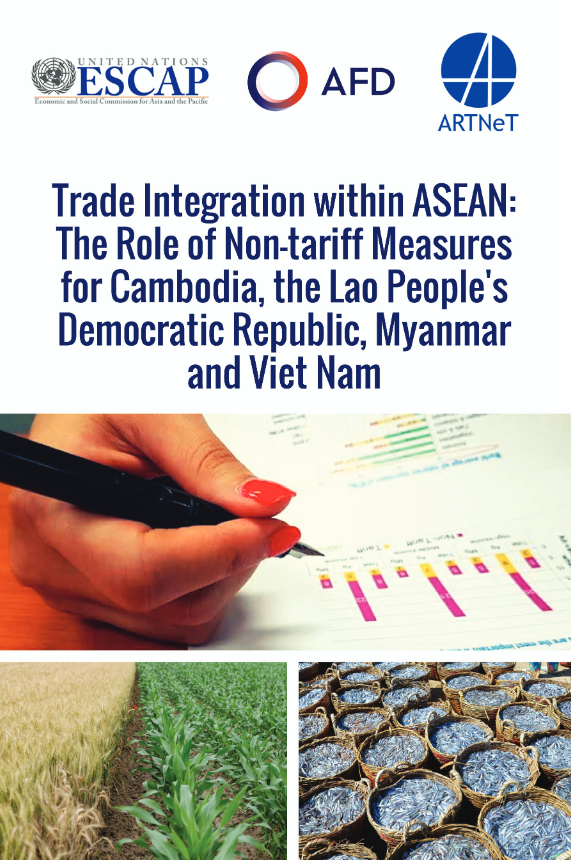Trade integration within ASEAN: The role of non-tariff measures for Cambodia, the Lao People`s Democratic Republic, Myanmar and Viet Nam

In 2014, the Agence Française de Développement (AFD) decided to launch and finance a research and capacity-building project on economic integration within ASEAN. More specifically, the project was aimed at dealing with the specific problems that the four less prosperous countries of ASEAN (i.e., Cambodia, the Lao People’s Democratic Republic, Myanmar and Viet Nam, collectively known as the CLMV group) would have to cope with in the context of the ASEAN Economic Community (AEC), which was to be fully realized by the end of 2015. The first phase of the project, which was carried out in partnership with the Asian Development Bank Institute (ADBI), dealt with reforms in the agriculture sector. The second phase, the results of which are presented in this publication, concentrated on non-tariff measures (NTMs) and geographical indications. This phase was carried out in partnership with researchers from the Asia-Pacific Research and Training Network on Trade (ARTNeT) and its secretariat at ESCAP.
This research project is emblematic of one of the two pillars of AFD research activities. Apart from gaining knowledge to improve its own operations, AFD also aims at promoting policy dialogue on development by supporting research centres and think tanks based in developing and emerging countries. The CLMV project is a perfect example of how a research and policy support programme can be designed to run concurrently with national or regional development strategies as well as serve as a knowledge backstop for policymakers and other key stakeholders.
The substantial gap in economic development between CLMV and the other members of ASEAN appears to be one of the key challenges facing the region and its ability to fully realize the benefits from regional integration. Cambodia, the Lao People’s Democratic Republic and Myanmar are now middle-income developing countries while Viet Nam is consolidating its status of a dynamic exporter, and they face a different global environment from the one faced by the ASEAN-6 when they were at the similar level of development. After the negative impact of the global financial crisis of 2008/09 on merchandise trade, the recent depression (2011-2015) is slowly correcting being corrected, although more in terms of value than volume. With some main international production networks reaching maturity with less or no expansion, the signs point to a longer-term slow trade growth. Moreover, the ability to benefit from market access depends increasingly on compliance with trade regulatory measures such as sanitary and phytosanitary requirements and goods standards as well as many other standards such as behind-the-border measures. The CLMV group faces this problem on both sides of their borders, which increases their trade costs and reduces their ability to follow the ASEAN-6 in exploiting trade and regional integration effectively for their development, even though regional trade is expected continue to grow. As a matter of fact, ASEAN’s greatest success has been in the area of tariff reductions. On average, 96% of tariff lines are at zero per cent and more than 70% of intra-ASEAN trade travels at a most-favoured nation rate. Nowadays, more than 70% of total trade between ASEAN members is conducted with zero tariffs. However, tariff liberalization is certainly not the end of the story, especially for the CLMV group whose economic structures still lag compared to those of other ASEAN members.
These are the reasons why the second phase of the AFD project was aimed at the implementation of policy-oriented research activities, a research capacity development programme and the sharing of knowledge about NTMs and geographic indications (in the broader context of trade-related intellectual property rights). The objective was to strengthen the technical and analytical skills of CLMV officials and researchers in managing the use of such tools in making assessments. Taking into account ESCAP’s overall capacity-building work, synergies were found with other projects, such as “reducing obstacles to international trade and investment in Asia and the Pacific”. Moreover, ARTNeT’s management skills in carrying out research programmes is a guarantee of good-quality outcomes, which is clearly demonstrated in this publication.
The ASEAN fell short of its target of fully realizing the AEC by the end of 2015, as 105 of its 506 measures were deferred. A successor blueprint called the AEC blueprint 2025, which lays out the work for ASEAN economic integration in the next 10 years, was therefore adopted at its twenty-seventh summit in November 2015. Among many other provisions, greater emphasis is being placed on harmonizing standards and regulatory convergence, a field that directly considers NTMs and geographic indications. When every ASEAN country accepts and enforces commonly defined standards and mutually recognizes geographic indications, ASEAN will become more of a single market.
It is hoped that the research work carried out by the project, together with the many exchanges of views between participants, will contribute to better preparation by the CLMV group in adopting an equitable framework for trade facilitation under the 2025 perspective.
